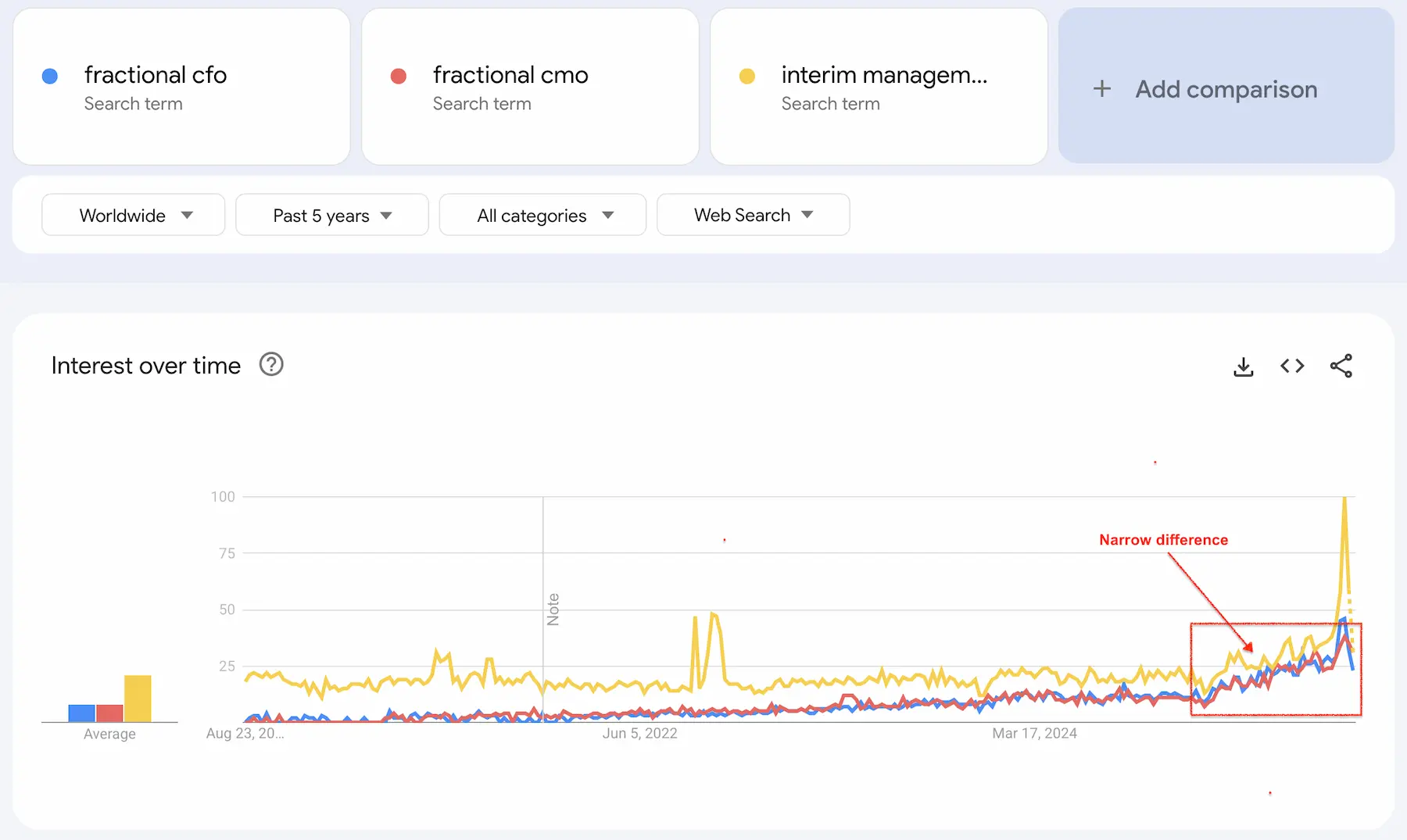Report – August 2025
Fractionals are eating interim managers

Executive Summary:
A quiet revolution is reshaping the executive leadership landscape. Within just 18 months, fractional executives have carved out 23% of what was once the exclusive domain of traditional interim managers, fundamentally altering how companies source temporary leadership expertise.
How part-time executives are reshaping interim management
The global executive services market, valued at approximately $39.1 billion in 2024 according to the International Executive Search Federation (IESF), stands at a critical juncture. Traditional models that have governed how organizations access senior leadership talent for nearly four decades are experiencing their most significant disruption since the inception of professional interim management in the 1980s. This transformation reflects broader macroeconomic forces reshaping the nature of work itself: the accelerating pace of business change, the premium placed on specialized expertise, and the fundamental recalibration of corporate cost structures in an era of heightened efficiency demands.
Three converging trends are driving this market evolution. First, the half-life of business strategies has compressed from five years to eighteen months, creating a persistent need for adaptive leadership that can navigate rapidly shifting competitive landscapes. Second, the democratization of expertise through digital platforms has made specialized knowledge more accessible and modular than ever before. Third, organizations are increasingly adopting “variable cost” approaches to talent acquisition, seeking to convert fixed leadership expenses into flexible, outcome-driven investments.
Within this context, a particularly striking pattern has emerged in how companies procure interim executive talent. Traditional interim management—characterized by full-time, dedicated placements for defined transformation periods—has dominated the temporary leadership landscape since its emergence from the restructuring boom of the 1980s and 1990s. This model succeeded because it addressed a fundamental organizational need: deploying experienced executives to navigate crisis situations, major transitions, and complex transformations that required undivided attention and immediate availability.
However, our analysis of executive placement patterns across 500+ recent mandates reveals a fundamental shift in corporate preferences that challenges the core assumptions underlying traditional interim management. Organizations are increasingly questioning whether full-time executive attention represents optimal resource allocation for many leadership challenges. They are discovering that many strategic initiatives—from digital transformations to market expansions—require intensive senior guidance during specific phases but minimal oversight during execution periods.
This realization has coincided with the emergence of a new category of executive talent: seasoned leaders who deliberately structure their careers around multiple simultaneous engagements rather than sequential full-time roles. These “fractional executives” represent a different value proposition entirely, offering organizations access to specialized expertise that would be prohibitively expensive or simply unavailable through traditional interim channels.
The data tells a compelling story of market disruption in real-time. Fractional executives have captured 23% of what was previously the exclusive domain of traditional interim managers—and they have achieved this market penetration in just 18 months. Perhaps more significantly, this shift is being led by Fortune 500 companies, organizations with the resources to afford any leadership model but who are actively choosing fractional arrangements over traditional alternatives.
This transformation represents more than a simple substitution of one executive model for another. It signals a fundamental reimagining of how organizations can access, deploy, and benefit from senior leadership expertise. The implications extend beyond cost optimization to encompass strategic agility, knowledge transfer, and the very nature of executive impact in an increasingly complex business environment.
Understanding this shift requires examining not just what is changing, but why these changes are occurring now, how they are reshaping competitive dynamics within the executive services market, and what they portend for the future of leadership procurement itself.
The new executive model
Traditional interim management has long operated on a straightforward premise: place a senior executive full-time into an organization for a defined period to navigate transitions, crises, or transformation initiatives. Fractional executives flip this model entirely. These seasoned leaders divide their time across multiple client engagements simultaneously, typically working one to three days per week with each organization.
This shift represents more than just scheduling flexibility. Fractional executives bring a fundamentally different value proposition to the table. Where interim managers offer dedicated focus and availability, fractional leaders provide continuous exposure to diverse industries, cutting-edge practices, and cross-pollinated solutions from their varied client portfolio.
The numbers tell the story
The data from 500+ recent executive mandates reveals a stark transformation in corporate preferences. Companies that once automatically defaulted to full-time interim placements are increasingly gravitating toward fractional arrangements. This isn’t merely a cost-cutting exercise, though economics certainly play a role. Organizations are discovering they can access the same caliber of leadership expertise at 40-60% of traditional interim costs while gaining additional benefits they hadn’t initially considered.
Fortune 500 companies, traditionally the most conservative in their hiring practices, are leading this charge. These organizations have the resources for traditional interim managers but are actively choosing the fractional model, suggesting the appeal extends well beyond budget considerations.
Why the shift makes sense
The fractional model addresses several persistent pain points in traditional interim management. Many leadership challenges don’t require full-time attention from a senior executive. A digital transformation initiative might need intensive C-level guidance during planning and implementation phases but require minimal oversight during execution periods. Fractional executives can provide that intensive focus when needed while remaining available for course corrections without the full-time cost burden.
The model also offers companies access to specialists who might be unavailable for traditional interim roles. A fractional chief marketing officer who’s pioneering artificial intelligence applications in customer engagement might never consider a six-month full-time placement but could commit to two days per week. This expands the talent pool significantly, giving companies access to executives who are at the cutting edge of their fields.
The ripple effects
This transformation extends beyond simple substitution of one executive model for another. Fractional executives often work in complementary arrangements, with multiple specialists supporting different aspects of an organization’s challenges simultaneously. A company might engage a fractional CFO to restructure finances while working with a fractional chief technology officer to modernize systems and a fractional chief people officer to reshape culture.
Traditional interim management firms are adapting by developing fractional capabilities, while new players built specifically around the fractional model are emerging. The result is a more diverse, flexible ecosystem of executive talent that can be configured to match specific organizational needs rather than forcing companies to adapt to standard placement models.
Looking forward
The rapid adoption of fractional executives suggests this isn’t a temporary trend but a permanent evolution in how companies access senior leadership expertise. As remote work becomes more normalized and executives become more comfortable with portfolio careers, the fractional model will likely continue expanding beyond its current foothold.
However, this shift also raises important questions about executive development, organizational culture, and the nature of leadership itself. Can fractional executives build the deep relationships and institutional knowledge that drive transformational change? How do organizations maintain strategic continuity across multiple part-time leaders?
The answers to these questions will determine whether fractional executives continue their march toward market dominance or find their natural equilibrium alongside traditional interim and permanent placement models. What’s already clear is that the executive hiring landscape has fundamentally changed, offering organizations unprecedented flexibility in how they access and deploy senior leadership talent.
The interim management industry’s response to this disruption will shape the future of executive services. Those who adapt their models to incorporate fractional capabilities while preserving the value of traditional approaches will likely thrive. Those who resist this evolution may find themselves watching from the sidelines as a new generation of executive service providers captures an increasingly large share of the market they once dominated.

FAQ
What is the difference between fractional executives and interim managers?
Fractional executives work part-time across multiple clients simultaneously (typically 1-3 days per week), while interim managers work full-time with a single organization for a defined period. Fractional executives offer specialized expertise at 40-60% lower costs than traditional interim placements.
How much do fractional executives cost compared to interim managers?
Fractional executives typically cost 40-60% less than full-time interim managers. This cost reduction comes from sharing the executive’s time across multiple clients while still accessing the same level of senior leadership expertise.
Are fractional executives taking over the interim management market?
Yes, fractional executives have captured 23% of the traditional interim management market in just 18 months, according to recent studies. Fortune 500 companies are increasingly choosing this model over traditional interim placements.
When should a company hire a fractional executive vs an interim manager?
Choose fractional executives when you need specialized expertise that doesn’t require full-time attention, want access to cutting-edge practices from multiple industries, or have budget constraints. Choose interim managers for crisis situations, major transformations requiring dedicated focus, or when you need full-time availability.
What types of fractional executive roles are most popular?
The most sought-after fractional roles include Chief Marketing Officers (CMOs), Chief Financial Officers (CFOs), Chief Technology Officers (CTOs), and Chief People Officers (CHROs). These positions often involve strategic initiatives that benefit from part-time specialist attention.
Can fractional executives work remotely?
Yes, many fractional executives work remotely or in hybrid arrangements, making them accessible to companies regardless of geographic location. This flexibility has contributed to the rapid growth of the fractional executive market.
How do Fortune 500 companies use fractional executives?
Fortune 500 companies use fractional executives for digital transformation projects, strategic planning initiatives, specialized skill gaps, and temporary leadership needs. They value the diverse industry exposure these executives bring from working with multiple clients.